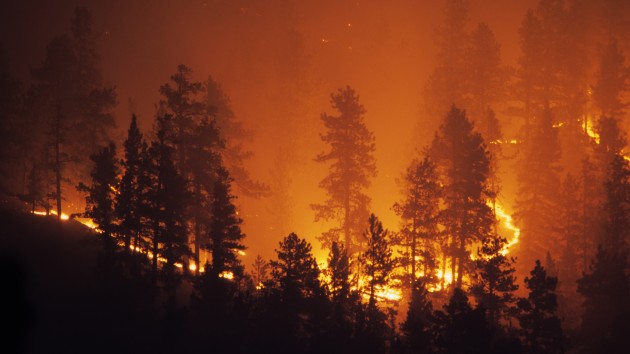By KARMA ALLEN, ABC News(NEW YORK) — With record wildfires raging throughout the West, public safety experts said it’s critical for residents to protect their lungs from poor air quality.
Wildfire smoke is typically a harsh mix of gases and fine debris from scorching trees and plants, buildings and other material, according to the Centers for Disease and Control and Prevention.The smoke can be harmful to both animals and humans, and people with preexisting lung conditions, children and pregnant women are especially at risk for becoming seriously ill from poor air quality. People with asthma are warned to keep their inhalers with them at all times when traveling to wildfire-prone areas.Outdoor air pollution accounted for 4.2 million premature deaths worldwide — mostly in low- or middle-income countries — in 2016 due to stroke, heart disease, lung cancer and respiratory diseases, like asthma, according to the World Health Organization.Here are a few simple tips from health experts on how to protect yourself from dangerous air pollution:
Monitor local air quality trackersIt’s important to stay on top of daily air pollution forecasts in your area. Many cities provide forecasts to help residents navigate areas where air quality may be worse, especially neighborhoods where families were forced to evacuate due to wildfire danger.Experts said online pollution tracking apps as well as local radio and TV weather reports are a good place to start. They also recommended the government’s online tool at AirNow.gov to check for daily air quality warnings.Be sure to familiarize yourself with the Environmental Protection Agency’s Air Quality Index, which runs from 0 to 500. The higher the AQI value, the greater the level of air pollution and the greater the health risks. Anything below 50 represents good air quality, while an AQI value over 300 represents hazardous air quality, according to the EPA.The index is color-coded and divided into six categories, making it easy for people to quickly determine if air quality is approaching unhealthy levels in their area. Each category corresponds to a different level of health concern.
Limit outdoor exerciseWhile it may be easier said than done for some sports enthusiasts, avoiding heavy outdoor activities is key when pollution levels are on the rise. For those desperate to meet step counts for the day, experts said walking indoors in a shopping mall or jogging up and down the stairs at home can be just as beneficial as walking thorough the park.Naturally, indoor gyms and at-home exercise machines are also healthy alternatives to outdoor workouts when air quality is low.
Avoid heavy traffic areasEven when air quality forecasts are good, car fumes from busy roads and highways can also worsen surrounding air quality. Experts said pollution from busy roadways can be felt up to one-third of a mile away.If you’re looking to work out outdoors on days when forecasts permit, experts say it’s best to stay as far from busy roadways as possible, especially if you live in high-pollution areas.
Step it up at schoolIn addition to limiting outdoor play for children, consider connecting with other parents and caregivers who are also interested in protection from the air quality.Try forming groups among parents and adults to encourage indoor play when quality is low and ask school leaders to consider more energy efficient policies.The EPA’s Clean School Bus Campaign is one of several U.S. school initiatives aimed at cleaning up emissions.
Use energy efficientlyIn general, try to conserve as much energy as possible at home to cut down on long-term air pollution. Electricity and other sources of energy are major contributors to air pollution, but experts say reducing energy use can help improve air quality over time by curbing greenhouse gas emissions.It’s also important to encourage those close to you to do their share as well. Visit the EPA’s website for a few tips to save energy, and money, at home.Copyright © 2020, ABC Audio. All rights reserved.












